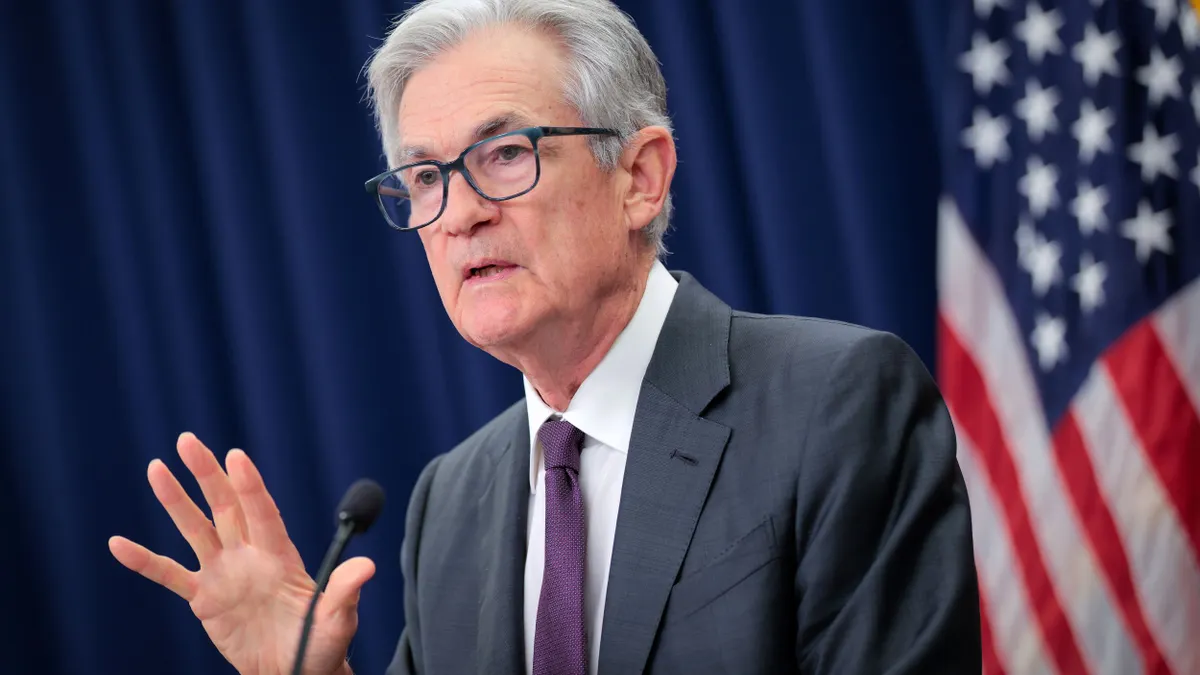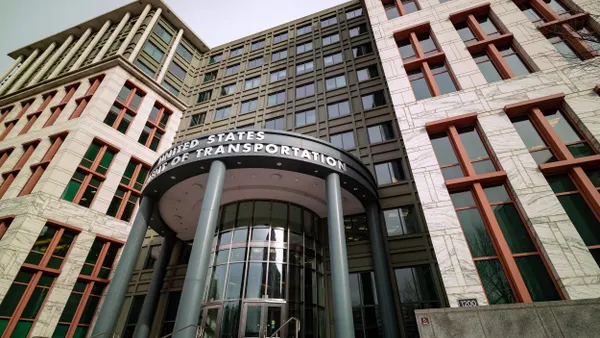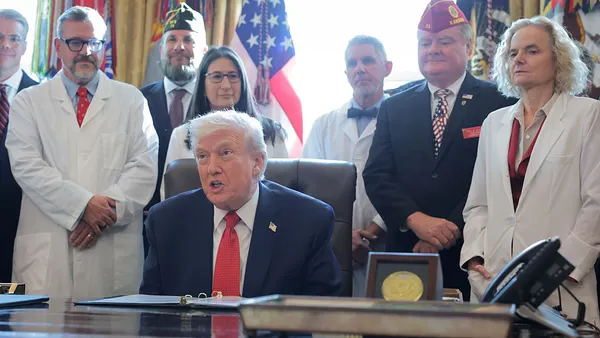Dive Brief:
- The Federal Reserve on Wednesday trimmed the benchmark interest rate by a quarter point to a range between 4% and 4.25%, citing weakness in the job market and forecasting two more quarter-point cuts this year.
- In a median projection, Fed officials estimated that they will reduce the federal funds rate to 3.6% by the end of 2025, or 0.3 percentage point lower than their June projection. They marked up their forecast for economic growth this year to 1.6% from 1.4% in June, while leaving their end-of-year projections for unemployment and inflation unchanged.
- The unemployment rate “has edged up, job gains have slowed and downside risks to employment have risen,” Fed Chair Jerome Powell said after a meeting in which Fed Governor Stephen Miran cast a dissenting vote, favoring a half-point reduction to the main rate. “At the same time, inflation has risen recently and remains somewhat elevated,” Powell said, highlighting the policy challenge of simultaneously managing a cooling job market and rising price pressures.
Dive Insight:
Policymakers reduced borrowing costs for the first time in 2025 as concerns about a decline in hiring prompted them to put on hold long-running efforts to curb inflation to their 2% target.
The job market in recent weeks has flashed several warning signs.
The Bureau of Labor Statistics last week announced a record revision of job growth during the 12 months through March. Payroll growth will probably be slashed by 911,000, or 0.6%, the BLS said in a preliminary report.
Also, overall U.S. hiring fell in August, and unemployment rose to 4.3% from 4.2% in July, the Labor Department said this month.
At the same time, inflation accelerated last month to the fastest pace this year. The Consumer Price Index rose 0.4% in August — 2.9% on an annual basis — after a 0.2% monthly gain in July, the Bureau of Labor Statistics said last week.
Based on their median estimates, Fed officials expect that the unemployment rate will end 2025 at 4.5%, the same as their June forecast. They forecast that their preferred measure of inflation — the personal consumption expenditures price index less volatile food and energy prices — will end the year at 3.1%, also the same as their June estimate.
The current mix of faster inflation and slower hiring complicates efforts by the Fed to meet its dual congressional mandate to ensure both stable prices and maximum employment.
“In the near term, risks to inflation are tilted to the upside and risks to employment to the downside —– a challenging situation,” Powell said. “With downside risks to employment having increased, the balance of risks has shifted.”
Uncommonly high risks to both Fed mandates has prompted central bank officials to express a wider range of views on policy solutions, Powell said.
“It is such an unusual situation,” he said. “Ordinarily, when the labor market is weak, inflation is low, and when the labor market is really strong, that's when you are careful about inflation.
“So we have a situation where we have two-sided risks, and that means there's no risk-free path and it's quite a difficult situation for policymakers,” he said. “It's not at all surprising to me that you have a range of views.”
While facing a complicated set of policy options, Fed officials have the benefit of managing borrowing costs for a comparatively healthy economy, Powell said.
“The unemployment rate is 4.3%, the economy is growing at 1.5%, so it’s not a bad economy,” he said. “We’ve seen much more challenging economic times.”
President Donald Trump for several months has posed another complication for Fed Chair Jerome Powell, berating Powell as incompetent and calling on him to slash the federal funds rate to as low as 1%.
Trump and Senate Republicans rushed through the confirmation of Miran to a vacant Fed governor seat, which Miran will hold through January while on leave as Trump’s top economic advisor.
Trump also tried to remove Fed Governor Lisa Cook on allegations she violated the law when signing for mortgage loans before joining the central bank. A federal appeals court on Monday upheld an injunction allowing her to attend the Fed policy meeting.
Powell batted down a suggestion that Fed officials may buckle under political pressure.
“Look, it's deeply in our culture to do our work based on the incoming data and never consider anything else,” Powell said. “Everybody who's at the Fed really feels strongly that way.”
“We don't frame these questions at all, or see them, in terms of political outcomes,” he said.
Powell differed from a recent assertion by Miran, a Trump nominee, that the president’s tariffs have not fueled inflation.
“Higher tariffs have begun to push up prices in some categories of goods, but their overall effects on economic activity and inflation remain to be seen,” Powell said.
“A reasonable base case is that the effects on inflation will be relatively short-lived — a one-time shift in the price level,” he said. “But it is also possible that the inflationary effects could instead be more persistent, and that is a risk to be assessed and managed.”
At a nomination hearing before the Senate Banking Committee on Sept. 4, Miran said that, despite imposition of the highest import taxes since the 1930s, the prices of imported goods have fallen rather than increased.
“Imported goods have actually been getting cheaper relative to domestically produced goods, which is the opposite of what you'd expect to see if tariffs were inflationary,” Miran said.











